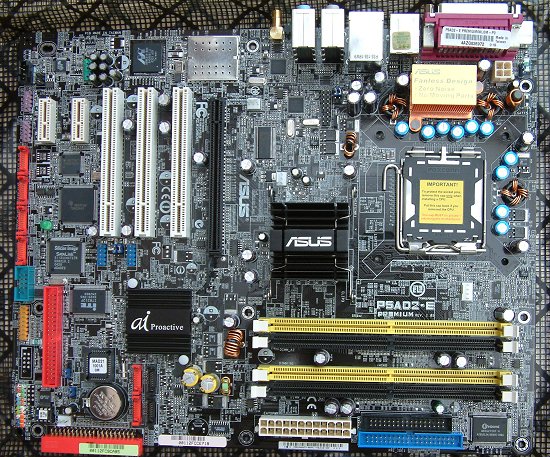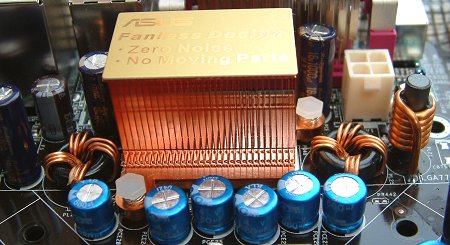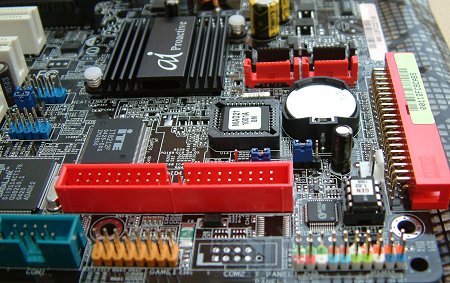Layout and features
If ASUS' 925X P5AD2 Premium board is anything to go by, it's features, features, and yet more features.
As you'd expect, layout is very, very similar to the P5AD2 Premium's. After all, why should ASUS abandon a formula and layout that has worked on a chipset that only differs from its predecessor by offering higher FSB support. However, both 925X and 'XE boards are different in layout to ASUS' similar 915P version. 900-series boards all support Intel's LGA775 CPU form factor. That translates to the usual CPU pins being located on the motherboard itself, with the CPU having compliant pads. Sure reduces instances of CPU breakage. ASUS thoughtfully places a plastic cover to stop inadvertent damage to the said motherboard pins.

Faster and faster CPU speeds have meant a re-think in cooling. ASUS has engineered a zero-noise motherboard that doesn't use any moving parts. Take it from me, fast-spinning 40mm fans, often located on top of bridge heatsinks, can be far more annoying than you'd imagine. ASUS splits up power connections' layout. The 4-pin 12v connector is placed on the far side, whilst the main 24-pin connector sits alongside floppy and primary IDE ports.

And here it is. One can run two sets of dual-channel RAM, offering, for most users, a maximum of 4GB system memory. ASUS has also made it easy for the user to engage and disengage memory modules without having to meddle with the PCI-Express X16 slot. Note how there's only a single IDE connector here. That seems to be the norm for ASUS 900-series boards, so hooking-up more than a couple of PATA devices will require the use of the discrete RAID controller's two red PATA ports. The 925XE chipset is traditional from a design point of view. You can see both north and southbridges covered by small-ish heatsinks.

Storage on the P5AD2-E Premium is RAID heaven. Moving on down shows 4 SATA ports sitting right next to Intel's ICH6R southbridge that supports Intel's Matrix Storage Technology. RAID0 and RAID1 formats are available, but RAID0+1 isn't. However, that blip is specification is, in my eyes, more than made up by support of Native Command Queuing (NCQ). A touch further down is ITE's 8212F that supports a couple of ATA channels, shown via red ports. You can run ATA devices in non-RAID mode, as well as RAID0, RAID1, RAID0+1.

ASUS' RAID and storage adventures aren't finished. Topping it all off is Silicon Image's Sil3114 4-port PCI-based SATA controller. That pushes up the board's total storage count to no less than 8 SATA ports and 3 ATA channels; just make sure you get a large enough case if you're intending on using them all concurrently. The only slight blight on this extraordinary storage potential is the use of the slower, limited PCI bus for discrete support. It'll be nice when controllers are run off the board's PCIe lanes. Speaking of which, the P5AD2-E Premium has a couple of PCI-Express X1 slots, 3 standard PCI (32-bit, 33MHz) slots, and an X16 slot reserved for graphics cards.
FireWire support, in this case both 400 and 800 protocols, is implemented via the combined use of Texas Instruments' TSB81BA3 transceiver and TSB82AA2 link layer. Both ASICs sit right next to the two PCI-Express slots. A whole host of discrete ASICs often impact on a board's layout in a negative manner. ASUS, I feel, has done an excellent job with PCB layout thus far.
Premium wouldn't be premium if WiFi wasn't present in some form. Rather than use the established method of providing an additional PCI-based controller card, ASUS has incorporated WiFi brains directly on to the chipset. Marvell's 88W8310 ASIC drives the board's 802.11b/g. Like any form of board integration, however, ASIC failure would require a replacement board.

The I/O section is symptomatic of the P5AD2-E Premium's focus on features. There's actually not enough room on a standard I/O layout to house all the board's functions. The remaining feature set is utilised through a series of brackets. 8-channel sound, run through a combination of Intel's High-Definition (Azalia) onboard sound and CMI's 9880 CODEC is well-catered for, both in terms of outputs and S/PDIF functionality. 4 USB 2.0, a single FireWire400, and an RJ45 port for one of the board's two PCI-Express-driven Gigabit Ethernet controllers are shown here. The WiFi conduit can also be seen on the far right-hand side.
If motherboard were simply evaluated on the basis of features above all else, ASUS would put a strong case forward with the P5AD2-E Premium. Storage is vast, layout is good, and every feature has a deluxe feel to it.









